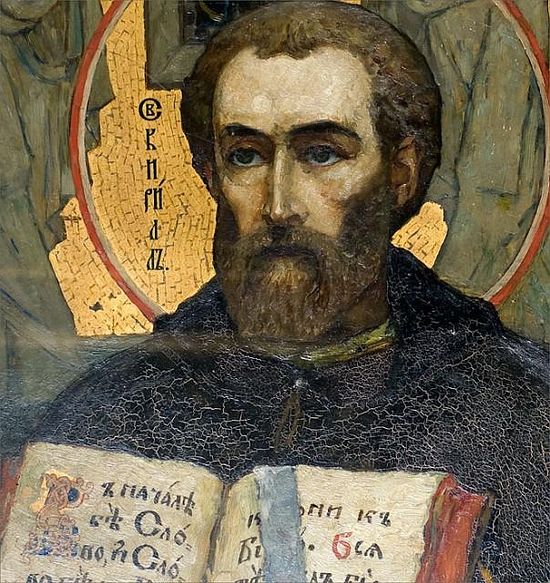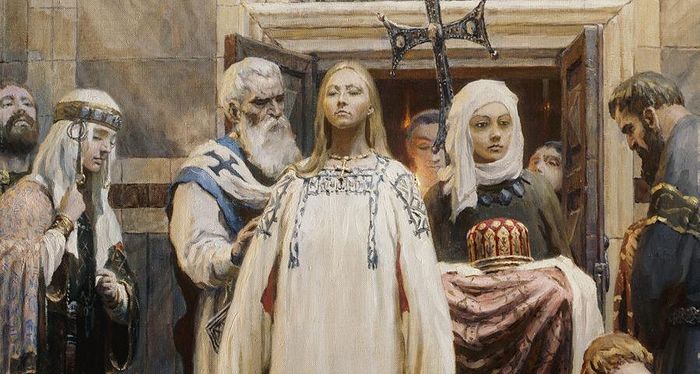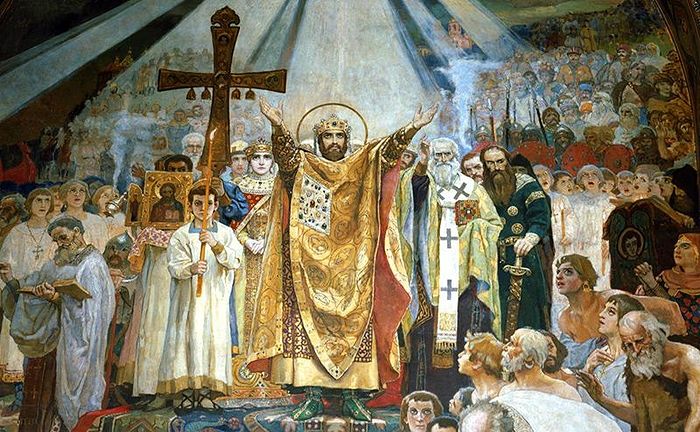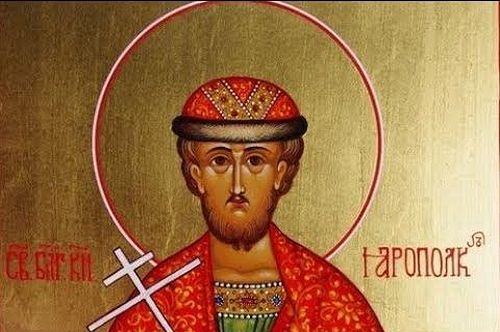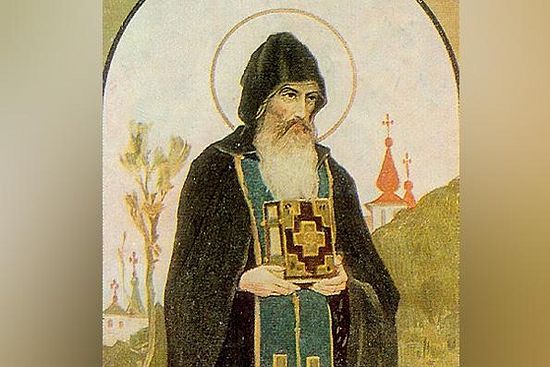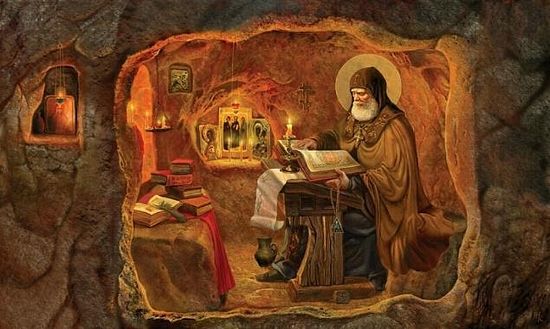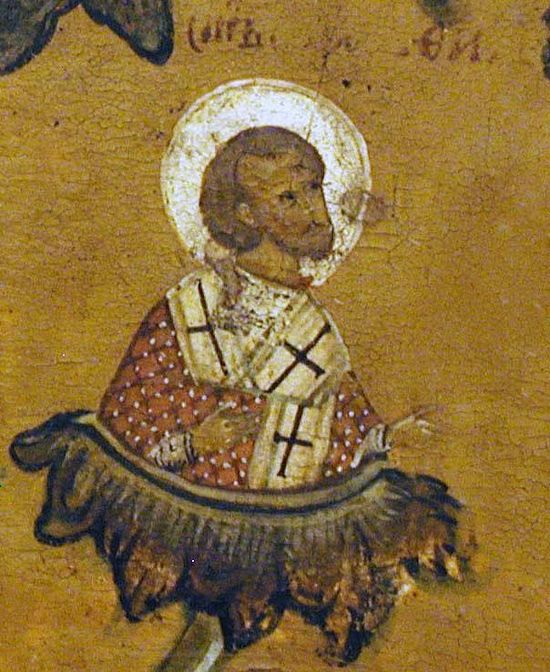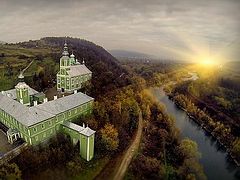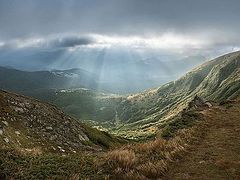Volhynia
St. Cyril, Enlightener of the Slavs
St. Methodius, Enlightener of the Slavs
St. Olga
St. Vladimir
Zymne Monastery
St. Barlaam of the Caves
St. Yaropolk of Vladimir-Volynksy
St. Stephan of the Cave
St. Nestor the Chronicler
St. Amphilochius of Vladimir-Volynsky
“My Volyn! Meadowland of Ukrainian forests, you are my beauty; my land of sunshine!”
We found it at Fields-of-the-Forest! Let us go where He is waiting and worship at his footstool! Thus are the sacred words of Psalm 131 as chanted in the Liturgy of the Presanctified Gifts according to the Romanian tradition. Would it surprise you to know that whenever I hear the words of this ancient Hebrew psalm glorifying King David, sung in a Romanian Church, the first thing that comes to mind is a forested meadowland in North-Western Ukraine?
My darling Volhynia! My beautiful woodland realm of endless green fields of the forested reaches of Red Ruthenia. You are wonderful in your saints; they are the adornment of the Russian Church. May your priests be clothed with your righteousness may your faithful people sing for joy,1 so that their light would shine before men and glorify your Father who is in heaven.
On October 10 (Old Style)2 in the Holy Orthodox Church, we commemorate and offer unto God all the Saints who have shown forth in the Volhynian lands—The Synaxis of Volhynian Saints! Let’s spirituality pass through the history of their land as we study their lives, and through their prayers, may God preserve the suffering Ukrainian lands and make her unconquerable against those who would work strife, as He intervened of old for them, and the good of all His Church.
If Kiev is the capital of Ukraine, if Poltava is the heart, and Transcarpathia is the spirit, then Volhynia is the soul.
To understand the soul of Volhynia itself, one can read the lives of her saints, or listen to this song “My Volyn”. With words such as “Polesian land so dear to me, you were my cradle and have become unto me a song”, one can understand how beloved this land is. I first heard this exact performance on a CD from Kiev Caves Lavra with musical works put together by Metropolitan Pavel, the Abbot of the Lavra and a native of Volhynia himself.
Volhynia or Volyn in Ukrainian, is essentially the northern part of Western Ukraine, though historically it can extend into Southeastern Poland and Belarus.
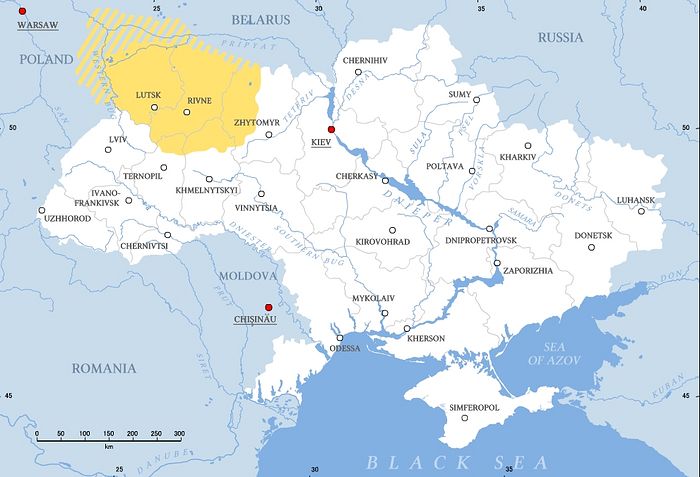 Volhynia roughly corresponds to the area in yellow. Photo: Wikipedia
Volhynia roughly corresponds to the area in yellow. Photo: Wikipedia
Volhynia is part of the natural and historic region of Polesia which literally means “in or along the forest(s)”.
Together with Galicia located directly to the southwest, with which it was once united in a kingdom, it forms nucleus of Western Ukraine, the spiritual capital of which is Pochaev Lavra in the Ternopil oblast. The historical reach and cultural region of Volhynia is larger than just the modern Volyn province, and also includes Rivne, and parts of Zhytomyr and northern Ternopil. Volhynia is known to be a very green land, to the north there are deep forests, and to the south large foothills approaching the Kremenets mountains of Pochaev.
I began this article with a quote from the Psalter, specifically Psalm 1313 as used during the Presanctified Liturgy of Our Father Among the Saints Gregory the Pope of Rome. I chose the version as used by the Romanian Archdiocese of North America, to pay homage to the great Holy Hierarch Peter Mohyla, Metropolitan of Kiev and Galicia, who was Moldovan by birth, born in modern day Romania, and who was included in the Synaxis of All Saints of Volhynia.4
Let's first read this entire text, with the important understanding that it describes the most noble desire of David to find the arc of the Covenant and make a dwelling place for the Lord:
Lord, remember David and all the hardships he suffered, and the oath he swore to the Lord, his vow to the mighty one of Jacob: not to enter tent or house, not to climb into bed, not to allow himself to sleep, not even to close his eyes, until he had found a place for the Lord, a home for the mighty one of Jacob! Listen: we heard it was in Ephrathah, we found it at Fields-of-the-Forest! *Let us go where he is waiting and worship at his footstool.
What always mesmerized me about this psalm, was hearing it chanted at a Romanian Church in its liturgical context.
First, the obscure description of this place called "Fields-of-the-Forest"; it always seemed so deep and mysterious to me. I am of course, not discussing this without purpose, but because hearing those enigmatic words always reminded me of Volhynia. If you know Ukraine, then if there is any place that could be called Fields-of-the-Forests—it's Volhynia.
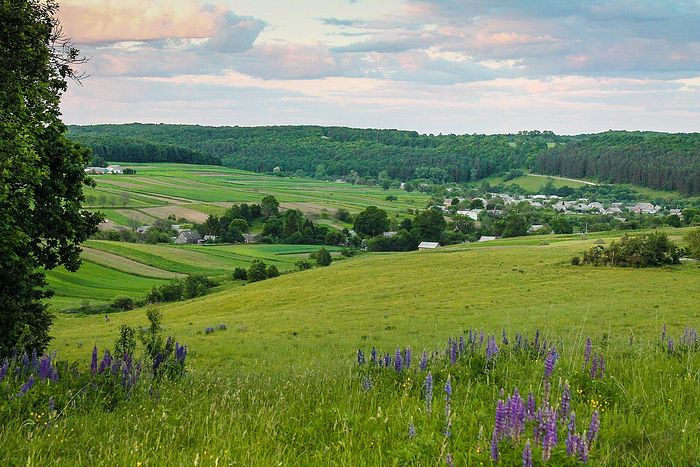 Rivne region of Volhynia Photo: Wikidata
Rivne region of Volhynia Photo: Wikidata
It's essentially a forested meadowland, where God created and painted in shades of green so iridescently profound you'll question if you've ever truly understood what green is.
But the symbolism goes back to the root of the psalm and its relation to the Synaxis of the saints of Volhynia, and not just because of its green forested fields..
King David the Ancestor of Our Lord is ardently searching for the Arc of the Covenant, which in the Old Testament contained the presence and dwelling place of God. It is with such hopeful triumph that it's declared "we found it..." and then I always remember how the next line was solemnly chanted "Let us go to His footstool..." and the church fell silent.
In the New Testament, the truest Arc of the Covenant is the Mother of God, as she became the dwelling place of the incarnate Logos, her womb becoming more spacious than all the starry fields of heaven, as it contained the One who hath made the heavens and the earth. The people of Volhynia never forgot the protection of the Mother of God, how she appeared eclipsing the evening star, and laid her sacred Protecting Veil over Pochaev Lavra, saving it— the most important holy site of Western Ukraine—from certain doom at the hands of a Turkish-Tatar horde.
This miracle happened of course through the prayers of the already reposed Saint Job of Pochaev, who appeared in the sky mediating to the Mediatrix of our souls for the salvation of his monastery. Centuries before that, the Theotokos laid her footprint at Pochaev, making it perhaps her fifth portion.
Without a doubt, the clearest typological analogue for the Arc of the Covenant in the New Testament is the Mother of God, and she appeared in Volhynia, in these new fields of the forest.
There is of course, another, more broad understanding, considering that in the Fields of the Forest, David sought the dwelling place of God.
The Priest exclaims during the liturgy, " Holy art Thou O God, and restest in the saints…", which is to say God is wonderful among his saints, among whom he deigns to dwell, including the Saints of Volhynia. He was with them in their sufferings and joys, and they are with Him in heaven.
As a result, just as David and the pious sought a dwelling place for the Lord (we heard it was in Ephrathah, we found it at Fields-of-the-Forest!), then God is also present in Volhynia, in the new Fields of the Forests on every single altar table of the canonical Ukrainian Orthodox Church, where his precious and life giving Body and Blood nourish the suffering and persecuted people with saving grace. There His priests, clothed in salvation worship at his footstool.
A key difference between the Orthodox and many Protestants, as well as schismatics, is that while the latter almost always see suffering as something to be avoided, sometimes with the idea (prosperity Gospel, the rapture) that God doesn't allow his elect to suffer, Orthodox people have never hid from suffering.
We know that while God won't always take us away from every bitter cup, when Christ was on the Cross, Our Lord remembers everyone who was ever born, and everyone who had yet to be born, and he suffered and died for us.
This is why persecutors of the church will always fail, because we as Orthodox are professional sufferers and persecution survivors. We've been doing it since 33 A.D.! We don't fear persecutors, we will outlast them! We don't fear suffering, we don't love it as we love grace, mercy, or wisdom, but we don't reject suffering for Christ's sake.
As Dostoyevsky said in his writers diary, “The most basic, most rudimentary spiritual need of the Russian people is the need for suffering, ever-present and unquenchable, everywhere and in everything.”
Russians know what it means to suffer. The pious people of Galicia and Volhynia above all know what it means to suffer. They've been suffering since the accursed Unia poisoned it and the blood of brotherly peoples, as Polish author Henryk Sienkiewicz said, and probably a long time before that too. A common sight in Volhynia is a cross atop a green flowering hill.
Of course, our Lord is no longer on the cross, He is Risen, and the people of Galicia have very a joyful version of this troparion. Perhaps the reason why the Orthodox never feared suffering, even crucifixion, is because we know that "after the crucifixion comes the resurrection"
Patriarch Bartholomew once said those words verbatim.
And now he has not only turned a blind eye to the suffering of his brothers in Volhynia, but he's actively supporting those who persecute them. The Rivne region alone is one of the hottest spots in the Ukrainian Church Crisis in terms of attacks and church seizures. The schismatics have declared their desire to seize Pochaev Lavra many times, and Pat. Bartholomew now supports the spiritual successors of the Turkish horde. But even the horde passed over like a wind in the peaceful meadowlands of St. Job of Pochaev, who shares the name of the great long-suffering Job.
This too shall pass. Heaven and earth will even pass, but God's word will remain forever, and we know that God reposes among the saints, including the saints of Volhynia who repose in the fields of the Forests of Red Ruthenia.
Let us then go to the lives of these saints and glorify God who made them glorious. Let us go there where he is waiting, and worship at his footstool.
A Synaxarion of the Saints of Volhynia
The Synaxis of the Saints of the Volhynian Lands is celebrated in the Russian/Ukrainian Orthodox Church on October 10 (Old Calendar), which is October 23 on the New Calendar. The celebration is held in honor of the reunification of Holy Dormition Pochaev Lavra with Orthodoxy on October 10, 1831; the Lavra had been previously occupied by Uniates—the very sect against which the famous saint and abbot Job of Pochaev had previously fought. This reunification was possible thanks to the help of the Russian tsar, and of course, the prayers of these wonderful saints.
As in many cases with feasts dedicated to all the saints of a particular land, many of these saints also belong to other feasts of other lands. Volhynia was of course, for most of its early history united with Galicia, and later part of various kingdoms. As a result, not all of these saints exclusively lived in Volhynia, though they were all connected with it in some way. The list will also continue to grow, as new saints are canonized, and of course, seeing as our faith is the living Body of Christ, it is only natural that future saints, even those yet to be born, who are revealed in the lands of Volhynia, will eventually be added to this Synaxis. On July 20, 2012, the Holy Synod of the Ukrainian Orthodox Church added 18 newly glorified martyrs to the Synaxis, as well as the Holy Hierarch Peter Mohyla, who also belongs to various other commemorations. As a result, this Synaxis is both a testimony to the holy luminaries of bygone years, but also a living call to holiness for the modern people of Volhynia to strive in the spiritual arena and become worthy of the legacy of these saints.
Below I will describe their lives, emphasizing the more obscure and less well known of them in the West, and linking to existing articles for more in depth information; while I will list them all, I will only go into extensive detail on the saints most deeply connected to the history and people of Volhynia—for not every saint on this Synaxis are as equally relevant to Volhynia itself, but some are included for other historical purposes. This Synaxarion was compiled using multiple sources, especially Archpriest Andrei Khoidatsky’s classic book “Orthodoxy in Western Russia and its closest representatives or the Patericon of Volhynia and Pochaev”. The Orthodox Encyclopedia Drevo was also a major source, as well as the Lives of the Saints from the OCA.
Here is our Synaxis of the Saints of Volhynia:5
Saint Cyril the Enlightener of the Slavs
Commemorated February 14/27, May 11/24
Holy-Equal-to-the-Apostles Cyril, Teacher of the Slavs Saint Cyril and his brother Saint Methodius should require no introduction, as they were the enlighteners to the Slavic peoples, who created the alphabet with which to teach the Gospel to the Slavs. While they are of course famous for the Cyrillic alphabet, which indeed may very well have actually been developed and finalized by their students, they also created the less well known Glagolitic, which is older than Cyrillic. Unlike Cyrillic, which is based on the Greek alphabet, Glagolitic uses an entirely unique writing system.
Because saints are very well known, I will simply link to several good articles here with more information about their lives.
Of course, it is important to note that these saints lived several centuries before the foundation of the Galician-Volhynian Principalities, and as a result, some may wonder why they are included in this synaxis.
Because their work literally laid the foundations for all later Slavic missions and churches, it is spiritually right, that they always be commemorated first among the Slavic saints, however there is of course more to this, as Saints Cyril and Methodius are also commemorated in several other Synaxes (Galician, Carpathian, etc.)
First of all, it must be understood that both saints are called “of Moravia” because Moravia, which is now essentially the Czech and Slovak lands, was the first well-documented union of Slavic peoples, and the location of their first mission.
Ancient Moravia is close to Transcarpathia and Western Ukraine, and existed at the height of the common Slavic period, when all Slavs essentially spoke mutually intelligible dialects of the same language, and were more like tribes of a single Slavic people, instead of being divided into nations. This commonality greatly aided the saints’ missionary work, as it allowed them to develop Church Slavonic, even basing it on their (possibly even native) Southern Slavic (Ancient Macedonian/Bulgarian) dialect, which remained fully comprehensible even to ordinary people as far as what would become Bohemia and Rus’.
The closest part of Rus’ to Moravia is Transcarpathia, Galicia, and Volhynia, and That is why Sts. Cyril and Methodius are commemorated in the Synaxes of each of those lands. The ancient Slavic peoples of those lands directly intermingled with ancient Moravians, including the White Croats who then lived in Transcarpathia.
Famous Carpatho-Rusyn Archpriest Dimitry Sydor goes farther, pointing out that the border between Moravia and Bulgaria at that time was Transcarpathia, and part of a major trade road which the saints and their students used. He goes as far as to say that Sts. Cyril and Methodius may be partially descended from, or otherwise have familiar relations with White Croats who moved to the territory of Thessaloniki.6
It is also worth noting that in Volhynia, specifically at the Ostrog Academy and under St. Job of Pochaev, great work was undertaken in Slavic printing, carrying on the tradition of Sts. Cyril and Methodius. Sts. Cyril and Methodius brought the Slavs literacy; and in Volhynia-Ostrog and Kiev, Sts. Job and Peter (Mohyla) worked to bring them the printing press.
Saint Methodius, Enlightener of the Slavs
Commemorated April 6/16 and May 11/24
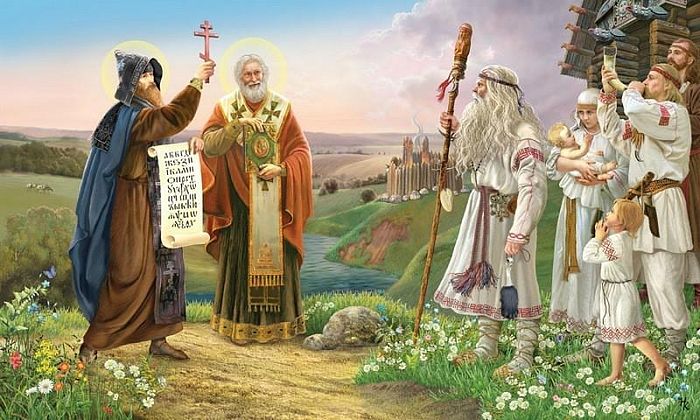 Saint Methodius is dressed as a bishop, holding the Gospel on the right.
Saint Methodius is dressed as a bishop, holding the Gospel on the right.
For more information on Sts. Cyril and Saint Methodius, see here.
Equal-to-the-Apostles Grand Princess Olga of Kiev and All Rus’
Commemorated July 11/24
St. Olga was the Russian warrior-princess who conquered a city and enemy tribe with an army of birds.
When you think of a great medieval military leader, do you imagine a princess warlord? Why not? Were it not for Saint Olga of Kiev, there might not have been a Russia today. This warrior-princess conquered the tribe that killed her husband, established one of the earliest tax systems, enamored the Roman Emperor so much that he wanted to marry her, burned a city to the ground using only birds, and is single handedly responsible for saving the very name of Russia.
Had it not been for her, what we call Russia today could be called Drevlia.
St. Olga was of course known, prior to her conversion to Christianity, for her war against the Drevlians, a Slavic tribe which means “people of the forest”. Volhynia as we have said is located in Polesia, which means “in the forest”—so we can see the connection.
Indeed, if we look at a map, the ancient lands of the Drevlians matches up roughly with the eastern end of Volhynia, and the ancient Drevlians and Volhynians were related Slavic tribes. Its important to note that St. Olga did not destroy the Drevlians, who murdered her husband and tried to force her into marriage, but still managed to keep these lands incorporated into Rus’ to the point that now it is seamlessly a part of northwestern Ukraine and southern Belarus. It is also highly likely that St. Olga took Malusha, the mother of her grandson, St. Vladimir from the Prince of the Drevlians and Volhynian lands, and the girl could have very well been a Volhynian herself, unlike Olga who was a Varangian (Scandinavian) from Pskov.
St. Olga the Godly-wise of Kiev is rightfully the Mother of all Rus’, and her memory is warmly kept in Volhynia, which remains today united with Kiev.
Equal-to-the-Apostles Grand Prince Vladimir of Kiev, Baptizer of all Rus’
Commemorated July 15/28
St. Vladimir of Kiev, Baptizer of Rus’, together with his holy grandmother Olga rightly belong on every synaxis of Rus’ saints ever to exist. As the deliverer of the Orthodox Faith to Rus’, Saint Vladimir’s legacy can be felt everywhere from Carpatho-Russia to the Pacific Ocean. From East to West, there is nowhere in Rus’ where the light of Vladimir “the Bright and Beautiful Sun” has not shined. For more on his life, here is a wonderful article from Saint Nikolai (Velimirovich).
Let’s focus on his contributions and legacy to the lands of Volhynia.
The first topic of interest is his birth. It should be said this was not described in the Primary Chronicle, or any other early source, and is thus largely unknown to us; we cannot say with any degree of scientific accuracy exactly where he was born.
Here it’s worth noting that one of the suggested birthplaces of St. Vladimir is in fact Volhynia! Vladimir the Bright Sun may indeed have been born there, considering he gifted this sunny land a very precious gift.
According to the Russian Chronicle, and to Patriarch Nikon’s Manuscript, the birthplace of St. Vladimir is recorded as being in Budutino or Budyatino (въ Будутинѣ) which corresponds to modern day Budyatychi, Volyn Oblast.78
His mother Malusha was likely the daughter of the Drevlian Prince with whom Saint Olga fought—Polessia being part of Volhynia and Drevlia, and meaning “in the forests”, with Drevlians meaning “people of the forest”.
Also supporting the theory that St. Vladimir was born in Volhynia, is the fact that he would later go on to found the city of Vladimir-Volynsky, which is located not far from this Budyatychi, and he later established a winter residence in the surrounding countryside.9
That being said, others suggest the birthplace of the saint as being in Pskov Oblast, the homeland of his grandmother Saint Olga.
Whether Saint Vladimir was born in Pskov or Volhynia cannot be said for certain, as there is evidence for both arguments.
What is certain is that Rus’ at the time was a single united Slavic people, and the birthplace and lives of her saints should never be used for nationalistic purposes, as all children of the Russian Church are equal in their inheritance and responsibility to the legacy of Holy Rus’ of which Saint Vladimir is the earthly father and progenitor of each and all.
St. Vladimir founded the capital of ancient Volhynia—Vladimir-Volynsky (Volodymyr-Volynskyi in Ukrainian), also known as Włodzimierz Wołyński in Polish, and the famous Lodomeria in Latin, as it was known in the Austro-Hungarian Empire. This Vladimir was the first in Rus’, founded by the saint together with its cathedra in 988, the same year as the Baptism of Rus’, long before the establishment of Vladimir-Suzdal by the decedents of St. Vladimir—which emphasizes how important Volhynia was in ancient Rus’.
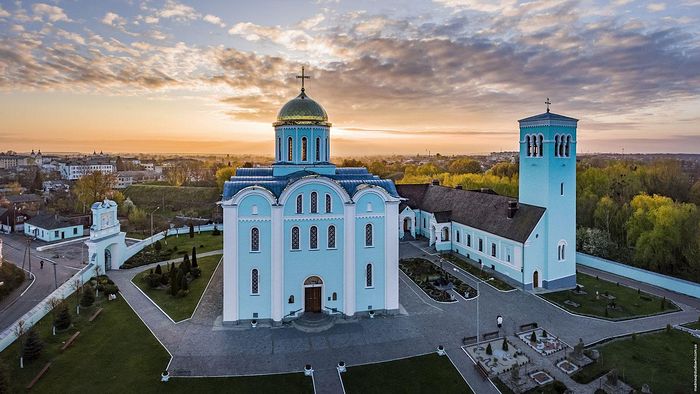 Vladimir-Volynsky. Photo: Ukrainetrek
Vladimir-Volynsky. Photo: Ukrainetrek
St. Vladimir placed his son Vsevolod on the throne of the Volhynian principality of Kievan Rus’, wisely considering the western borders to be strategically crucial (which proved to be true, considering Poland invaded during the interregnum after his death).10
According to ancient Volhynian chronicles, St. Vladimir built his winter palace in the village of Zymno (Zymne), around five kilometers from Vladimir-Volynsky, where he also established in 1001 the oldest monastery in Volhynia and all Western Ukraine—the Holy Mountain Dormition Monastery of Zymne.
 Holy Mountain Dormition Monastery of Zymne. Photo: monasteries.org.ua
Holy Mountain Dormition Monastery of Zymne. Photo: monasteries.org.ua
Prior to the establishment of Pochaev Lavra, the Zymne Monastery was considered the holiest place in Western Ukraine and is home to one of the most ancient, beloved, and venerable icons in Ukraine.
The Wonderworking Zymne Icon of the Mother of God was a most precious gift from St. Vladimir to the monastery revealing his deep love for the monastery and Volhynia—considering the crucial role the icon played in changing his life.
According to the Primary Chronicle, after seizing Korsun (in Crimea), which was a Byzantine territory, the still-pagan Grand Prince Vladimir demanded the hand of the Emperor’s sister Anna in marriage, who was then sent to him in Korsun.
At that time, Vladimir became seriously ill and fell blind, which greatly distressed him. It was Anna of Constantinople who told him that if he wanted to be healed, he must become baptized. Vladimir agreed, and said, “If this be true, then truly great is the God of the Christians”; and he accepted baptism.
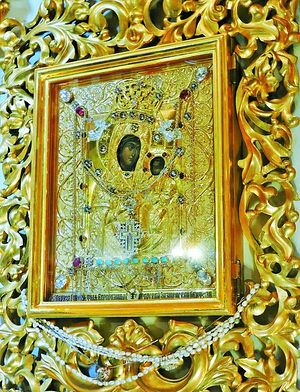 The Zymne Icon. wz.lviv.ua The moment he arose from the waters, his sight returned, and the first thing his newly healed eyes beheld was a warm light shining forth from the icon which was brought from Constantinople by Anna. For this and many deeper reasons, Saint Vladimir is commemorated by the church “as a second Paul”, just like St. Constantine, another Equal-to-the-Apostles who converted an entire civilization with the spiritual help of a (grand)mother.11
The Zymne Icon. wz.lviv.ua The moment he arose from the waters, his sight returned, and the first thing his newly healed eyes beheld was a warm light shining forth from the icon which was brought from Constantinople by Anna. For this and many deeper reasons, Saint Vladimir is commemorated by the church “as a second Paul”, just like St. Constantine, another Equal-to-the-Apostles who converted an entire civilization with the spiritual help of a (grand)mother.11
It was this very same icon which Patriarch Nicholas II Chrysostom of Constantinople blessed Vladimir and Anna with in their marriage.
In the year 1006, St. Vladimir donated this icon to the church of the Theotokos at Holy Mountain Dormition Monastery, and it became known as the Wonderworking Icon of Zymne ever since, as miracles never ceased to pour forth through it.
One can only imagine how precious Zymne had to be, for St. Vladimir to have gifted his personal family icon to the monastery, which seems to strongly indicate his deep connections to the Volhynian lands. The Icon was St. Vladimir’s gift to Zymne, and the Zymne Monastery was his gift to all Volhynia.
 Zymne Monastery, Photo: Wikpedia
Zymne Monastery, Photo: Wikpedia
The Venerable Barlaam of the Caves
Commemorated November 19/December 2
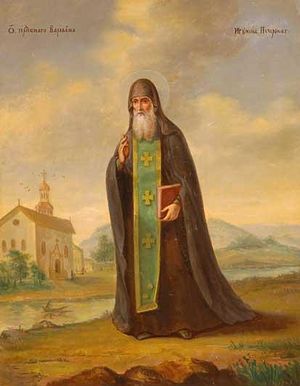 The Venerable Barlaam of the Kiev Caves was appointed by Saint Anthony of Kiev as the first Abbot of the Kiev Caves Lavra, (although Saints Anthony and Theodosius are commemorated as its founders). According to St. Nestor the Chronicler, St. Barlaam visited the Holy Mountain Monastery at Zymne twice while on pilgrimages to Jerusalem and Constantinople, as it was located near strategically important roads, connecting Kievan Rus’ with Byzantium and other powerful kingdoms; this road was likely traveled by Saint Anthony as well.
The Venerable Barlaam of the Kiev Caves was appointed by Saint Anthony of Kiev as the first Abbot of the Kiev Caves Lavra, (although Saints Anthony and Theodosius are commemorated as its founders). According to St. Nestor the Chronicler, St. Barlaam visited the Holy Mountain Monastery at Zymne twice while on pilgrimages to Jerusalem and Constantinople, as it was located near strategically important roads, connecting Kievan Rus’ with Byzantium and other powerful kingdoms; this road was likely traveled by Saint Anthony as well.
It is noted that the very similar caves network in Zymne, reveals the close kinship of the Holy Mountain Monastery near Vladimir-Volynsky to Kiev Caves Lavra.
It was in the Holy Mountain Monastery of Volhynian lands where Saint Barlaam died after returning from his second trip.12
The Right-Believing Yaropolk of Vladimir-Volynsky
Commemorated November 22/December 5
Yaropolk Izyaslavich (1086+) was the Prince of Vladimir-Volynsky. He endured many horrible misfortunes and sufferings with Christian patience; St. Nestor the Chronicler writes that he was meek and loving, and supported the church every year with a tithe. He was murdered in a way some compare to that of Boris and Gleb,13 and is buried in a monastery he helped build.
The Venerable Holy Hierarch Stephan of the Caves
Commemorated April 27/May 10
The Holy Hierarch Stephan of the Caves (+1094) was the third Hegumen of the Kiev Caves Lavra immediately succeeding St. Theodosius, as well as the second documented bishop of Vladimir-Volynsky, where he is known as St. Stephen II.
St. Stephan was elected Bishop of Vladimir-Volynsky in 1091, and he labored greatly to bring the people of Volhynia to Christ, as the Baptism of Rus’ happened not even one hundred years before.
His life came full circle when he returned to Kiev to participate in the canonization of St. Theodosius of the Caves and the translation of his uncorrupt relics. It was said that he sat one night, uncertain if he would attend the translation of the relics, when suddenly he saw the light of dawn shining in the darkness above the caves of Theodosius. The holy one was greatly saddened that he might miss the translation, and so he immediately mounted his horse and road to the Kiev Caves. When he arrived there the light disappeared, everything returned to night, and St. Stephan understood that he had seen a vision so that he would “see the light of divine glory shining from the pure relics of his [spiritual] father and teacher.”14
After that spiritual celebration, St. Stephan returned to his flock in Volhynia where for around three more years, he rightly carried out the blessed hierarchical service, according to the testimony of his contemporary Saint Nestor the Chronicler, “having worked many virtues, becoming worthy of the unfading glory of the [heavenly] crown.”15
The good shepherd of Volhynia fell asleep in his diocese on April 27, 1094, and was buried there in the Vladimir (Volynsky) Cathedral to the lamentation of the Volhynian flock, in a place now called “The Theodorian Lands”16 or “The Old Cathedra”17, which was once part of the city of Vladimir-Volynsky but is now located a few kilometers outside the city. Now that place is the village of Fedorivka, Volyn Oblast, Ukraine.18
The Venerable Nestor the Chronicler of all Rus’
Commemorated October 27/November 9
Saint Nestor the Chronicler (1113 or 1116+)19 requires no introduction to the student of Russian history, considering he literally wrote the book, as the first Russian historian. The Venerable Nestor is the author of the Primary Chronicle, which is, as he began the story, “the Tale of the Bygone Years from whence came the Russian lands, where in Kiev the first principality was established, and from what source the Rus’ lands have their origin.”
The tragic irony is that while thanks to St. Nestor, we know a great deal about ancient Rus’, we know very little concrete information about the life of the saint himself. Saint Nestor was born in the 1050s, most likely in 1056 in the lands of Kiev.
He entered the Kiev Caves Lavra around the age of seventeen and was tonsured a monk by St. Stephen, the successor of St. Theodosius of the Caves, the future Bishop of Volhynia.
Some of the precious few sources of information concerning the life of St. Nestor come from Volhynian records. In 1097, St. Nestor himself writes how he traveled to Vladimir-Volynsky “in search of schools and teachers”.20
St. Nestor was very interested in the schools of Vladimir-Volynsky, as during his time, they were among the oldest, most remarkable, and most extensive in all the lands of Rus’.2122
It’s important to remember that at this time Moscow had not even been founded, its predecessor state Vladimir-Suzdal was not yet established, and as a result, it was the older Vladimir—Vladimir-Volynsky that was one of the greatest centers of early Kievan Rus’.
Indeed, the Venerable Chronicler visited Volhynia not only for schools, but also to become acquainted with the history of the region, which after Kiev was at this time the main center of the political life of the Russian State during the Kievan Rus’ period, as Archpriest Andrei Khoinatsky, an expert on Western Rus’ writes.23 One can tell how important this region was to Saint Vladimir of All Rus’, considering that here, he donated his most precious family icon, which was intimately involved in the miracle of his conversion.
It is known that before the all-Russian chronicle of St. Nestor, in other extremely ancient Rus’ cities, such as Novgorod, there was a local chronicle in Volhynia—one which paid particular attention to the history of Southern Rus’ (or Western Rus’ depending on your view), which are the lands of modern Ukraine and Belarus.
Experts note that the Volhynian chronicle in many places was incorporated into the chronicles of St. Nestor, with almost a third of his entire works—the earliest complete Russian history—being devoted to the majestic Volhynian lands.24
Naturally, there was no better place to learn the history of Volhynia than its own capital—Vladimir-Volynsky, and especially in the Holy Mountain Dormition Monastery at Zymne, where according to scholarly consensus, the Volhynian chronicle was written.25
His work preserved the history of Volhynia together with the rest of ancient Rus’, and it still remains the primary source of Russian history to this day.
Saint Nestor reposes in the Kiev Caves Lavra, where his memory is kept on the day of his death—October 27/November 9.
The Holy Hierarch Amphilochius of Vladimir-Volynsky
Commemorated October 10/23
Among the holy God-pleasers resplendent in the lands of Volynia, Saint Amphilochius is one of those about whom we know very little, other than the fact that he was a bishop of Vladimir-Volynsky and was involved in matters concerning the canonization of St. Theodosius of the Caves.26
It is highly likely that he began his monastic labor in Kiev Caves Lavra. At that time in Rus', almost all bishops came from the Kiev Caves, including St. Amphilochius’ direct predecessor, St. Stephan II (mentioned above in this Synaxis), and his direct successor Bp. Simon, who like St. Stephan II was also an abbot of the Kiev Caves.27
Aside from that detail, in his history of Russian Saints, Archbishop Philaret of Chernigov was only able to specifically mention his date of ordination and repose.28
He was consecrated as a Bishop on August 27, 1105, by Metropolitan Nicephoros of Kiev.
According to historical records of the Vladimir-Volynsky diocese, he was recorded as the third bishop of Vladimir-Volynsky in recorded history, after Stephan I, who was placed by Equal-to-the-Apostles Vladimir of Kiev, and Stephan II.29
Here it's very important to note that the key word is “recorded” history. It is likely there were six bishops in between Stephan I and Stephan II, in order: Thomas the Greek (mentioned in 998), John, Anthony I, Anity, Kodrius, and Gelasi, making Amphilochius the ninth Bishop of Vladimir Volynsky.30
However as virtually nothing specific is known about them, St. Amphilochius can be considered the third bishop in the recorded history of Volhynia.
For seventeen years he ruled the Vladimir-Volynsky diocese. It is very important to remember the historical context; only a few generations separated his time from the Baptism of Rus', and he had to work hard to convert the remaining persistent pagans to Christ, as well as to eradicate pagan superstitions among the newly baptized nation and pacify princely feuds.
Although in some ways, it can certainly be said the Baptism of Rus' put an end to post-Viking era violence of the Viking-descended Rus' princes, in other ways, due to envy and pride inherent in fallen human nature, violence, as always, found its way.
During his reign in the diocese, stone church construction began—in particular, the church of St. John the Baptist in Przemysl was built.
Having left the diocese, he returned to Kiev where he continued his service to God, Who granted his desire to repose in the Far Caves of the Kievan Lavra.
In the pre-Mongolian period of Rus', all spiritual and political life revolved around Kiev. This was a time when, similar to the ancient Old Testament tradition of the spiritual authority of the old wise prophets, the abbots of the Kiev Caves and the Caves themselves were seen as more honorable and venerable than many episcopal cathedras, and as a result, all desired to live and repose there. Leaving the throne of a diocese to toil in the Caves again was not at all seen as a lowering of status; and no matter how far service to the church took one from Kiev, all the monastics and hierarchs dreamed of returning to Kiev.
St. Amphilochius reposed in 1122. It is said that there was a special path from Kiev to Volhynia which the monks of the caves took when on their way to serve in Vladimir Volynsky. This was likely the path that St. Vladimir took, as well as St. Barlaam (mentioned above in this synaxis), St. Amphilochius, and his successors.
The memory of this secret road was preserved among the monks of the caves, and when Batu Khan came and laid ruin to Kiev, the monks who fled went along this road of tears until stopping at what would become Lavra hill Pochaev, southern Volhynia, near Galicia, where the Mother of God appeared to them.
It was there where Pochaev Lavra would be founded, and it would continue the spiritual tradition and link with Kiev, the Holy Mountain Zymne Monastery, and St. Amphilochius.




